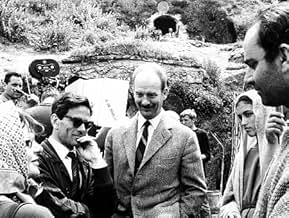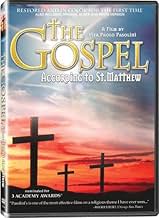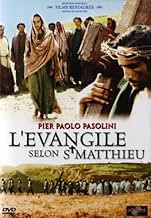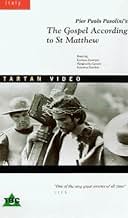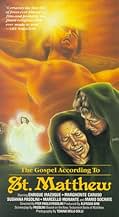VALUTAZIONE IMDb
7,6/10
14.502
LA TUA VALUTAZIONE
Segui la vita di Gesù Cristo secondo il Vangelo di Matteo.Segui la vita di Gesù Cristo secondo il Vangelo di Matteo.Segui la vita di Gesù Cristo secondo il Vangelo di Matteo.
- Regia
- Sceneggiatura
- Star
- Candidato a 3 Oscar
- 7 vittorie e 9 candidature totali
Juan Rodolfo Wilcock
- Caifa
- (as Rodolfo Wilcock)
Recensioni in evidenza
The Gospel According to St. Matthew (1964)
This is such a stately, respectful, yet contemporary (and dare I say, Italian) production, in quiet black and white, it's hard to find fault with it. In some ways, I think it does exactly what it intends. It mixes long shots with close ups. It moves with clarity and sharp (no dissolve) cuts from face to face. It uses African-American gospel and Bach. It depends on solemnity, and it uses actors that have the faces, and demeanors, to be utterly solemn and strong.
All the actors are amateurs. Pasolini was an atheist. The triumph at the end is a matter of record. It's all here.
The question might be (for some) whether it is nevertheless a movie you want to watch. And I say, absolutely. You do have to like, or learn to like, movies that are about quiet ambiance, about passive expressions that say more than intense extroverted acting. The black and white photography, something of a throwback during this early 1960s production, gives it even more of the timeless, almost melancholy depth that keeps it going, owing something to the Dreyer's Joan of Arc, I think.
It's important to know this is not really an interpretation of the gospel, but a reading of it. The filming of course required actors, but it tries to be factually straight forward. That's incredibly hard to pull off without arrogance or religiosity. But Pasolini does it. The down side to this is that it's slow, or even (no sacrilege here), boring. I mean, I read the book.
For me, what makes it terrific is not only how it is filmed (the camera-work and editing) and the faces (all those faces, with the camera still and focused on them), but the sense of reality here. The holiness is removed, but not the sacred seriousness. It makes it seem possible in a very real way. The people, the places, all of it is not historic, not in particular, but the effect, the mood, the force of it all is profound. Even for a non-believer. It's quite something to get swept into.
This is such a stately, respectful, yet contemporary (and dare I say, Italian) production, in quiet black and white, it's hard to find fault with it. In some ways, I think it does exactly what it intends. It mixes long shots with close ups. It moves with clarity and sharp (no dissolve) cuts from face to face. It uses African-American gospel and Bach. It depends on solemnity, and it uses actors that have the faces, and demeanors, to be utterly solemn and strong.
All the actors are amateurs. Pasolini was an atheist. The triumph at the end is a matter of record. It's all here.
The question might be (for some) whether it is nevertheless a movie you want to watch. And I say, absolutely. You do have to like, or learn to like, movies that are about quiet ambiance, about passive expressions that say more than intense extroverted acting. The black and white photography, something of a throwback during this early 1960s production, gives it even more of the timeless, almost melancholy depth that keeps it going, owing something to the Dreyer's Joan of Arc, I think.
It's important to know this is not really an interpretation of the gospel, but a reading of it. The filming of course required actors, but it tries to be factually straight forward. That's incredibly hard to pull off without arrogance or religiosity. But Pasolini does it. The down side to this is that it's slow, or even (no sacrilege here), boring. I mean, I read the book.
For me, what makes it terrific is not only how it is filmed (the camera-work and editing) and the faces (all those faces, with the camera still and focused on them), but the sense of reality here. The holiness is removed, but not the sacred seriousness. It makes it seem possible in a very real way. The people, the places, all of it is not historic, not in particular, but the effect, the mood, the force of it all is profound. Even for a non-believer. It's quite something to get swept into.
This is a movie of the biggest celebrity that has ever lived, Jesus.Enrique Irazoqui performs Jesus in this Pier Paulo Pasolini's masterpiece from 1964.Pasolini liked to use amateur actors in his films but all the actors still do a very fine job in this film.Pretty often you get to see American Jesus in movies like Willem Dafoe's perform in Martin Scorsese's The Last Temptation of Christ but this time the son of God speaks Italian.I saw Il Vangelo secondo Matteo on Easter and this is a perfect Easter movie.You don't have to read the Bible to watch this movie.You learn everything you want to know about Jesus from this movie.In this film Jesus isn't a long haired and bearded guy as he usually has been performed.Who knows what the man looked like.Many people say this is the best Jesus movie ever made.I can't say it is because I haven't seen them all but this a great movie anyway.Everything works perfectly even though this movie didn't have a big budget.The special effects weren't the main star in this movie but the actors were. I recommend this movie for every good human being.
After "La Ricotta", Pasolini was indicted by the church for blasphemy. The film apparently contained references to Homosexuality (it does). He was convicted and given a suspended sentence. So when it was announced that his next feature was "The Gospel According to St. Matthew," you can guess what the church's response was. Pasolini made the film anyway. The result is one of the most exciting examples of Pasolini's "Cinema of Poetry". I have read many comments about this film that criticize it for its elipses, bad acting and apparent lack of visual prowness. I will attest to you, though, that this film not only creates an honest 20th century portrait of Jesus but also dives deeply into Pasolini's masterful art of filmmaking. Pasolini was way ahead of his time like many other Italian filmmakers of the sixites. The supposed bad acting, elipses and visuals in the film were all done on purpose. They aren't bad. In fact, thay force a patient viewer to look deeply into the minds and thoughts of the characters surrounding Jesus. The Gospel has been told many ways, but no one ever dared to tell the story on a personal level. Pasolini invites the viewer to experience the Gospel in a differnt way. With a wonderful mix of religious music (American, Brazilian, etc.), the film reaches out to the entire Christian world. I can go on and on about the other wonders this film has to offer, but instead I'll just recommend you watch it. When you do, don't pay attention to what's missing, but to what is there on screen. The film will make a lot more sense. Even for non-believers (myself included), this is an exciting film.
I must say, as a new IMDb user I find this place to express one views a rather welcome find. Cathartic to say the least. Certain films haunt me. "The Gospel According to St Matthew" is one of them. The only possible explanation is the passion of its maker. Everything about it is so real that I remember the first time I saw it, I felt I had met Jesus. My relationship with Jesus had been torturous at best. Raised catholic by very catholic pre- Vatican Council parents. So, part of my rebellion had always been underlined by moving away from that pathology as far away as possible. Pasolini however, a Marxist homosexual, showed me a human side of the man I was suppose to follow that made sense, that touched me. Enrique Irazoqui plays Jesus in a way that may explain everything. He is just a guy but in his eyes, in his eyes there is something I've never seen before. Compassion without fake undertones. It chilled me. I loved him. I wanted to follow him. Pasolini wasn't trying to sell me anything, he wasn't trying to convert anyone he was doing what an artist, a real artist does. He was sharing his vision with me, with us. When people talk about movie experiences, this is the film that comes to my mind first. I'm glad to have to opportunity to share this with you.
Before I saw Pasolini's "Il Vangelo secondo Matteo" I was uncertain if I even wanted to see it. I was aware that when he made that film the director was influenced by Italian neorealism, a movement which has little appeal for me. At the same time, Pasolini's later films are some of the greatest ever made. Eventually, my love for Pasolini's later works won out and I saw the movie. While "Il Vangelo secondo Matteo" is indebted to neorealism, as in its use of non-professional actors, this does not in the least detract from its quality.
Enrique Irazoqui, who plays Jesus, gives an excellent performance. He brings an intensity and harshness to the role that is very much in accord with the Jesus portrayed in numerous passages of the gospels. Margherita Caruso, who plays Mary as a young women, is an inspired choice. Although she does very little, and I cannot truly commend her for her acting, she has an amazing presence in this film, combining serenity, holiness, and innocence.
Pasolini paces the film well. It never drags, and never passes over subjects or incidents too quickly. The heroic quality of Jesus' life is strongly emphasized, his confrontations with existing religious authorities, his preaching of his message throughout Palestine, his bravery before the Roman authorities, and so on. Through demonstrations of his resolve, composure, and sternness, a real sense of the courage and dynamism of the character of Jesus is produced.
Pasolini's choices of locations could not have been better, and the scenes are staged and filmed skillfully, emphasizing the right emotions at the right times, whether those are feelings of sympathy, courage, or awe. I would not go so far as to say that any of these elements demonstrate brilliance, but they are very well done.
I was impressed with Pasolini's use of the gospels, which provide the bulk of what the character of Jesus actually says. I might note, also, that the harshness of much of the message is left intact. Conservative Christians might find this appealing, in that the director does not sanitize the message. Certainly, the pope enjoyed it. Pasolini received a medal from him. Non-Christians, and more liberal Christians, might find parts of the message to be a little frightening. When some of the harsher elements, especially the religious exclusivism (i.e., only those who believe in Christ have hope) are heard as spoken dialogue, rather than as words printed on a page, their impact is much greater, whether it is more disturbing or more inspiring. The film is a powerful evocation of the life of an important religious figure, and can be enjoyed by both believers and non-believers.
The film does have it's faults, however. The scene in which the "massacre of the innocents" is shown is poorly done. I personally found the depiction of the event to be somewhat comical, which clearly was not Pasolini's intention. The score, which draws on a variety of genres of Christian religious music is, by itself, beautiful. Unfortunately, I felt that it did not complement the film. The juxtaposition of disparate musical traditions with one another, and with the harsh world being visually depicted weakened the effect of both, had either stood on its own. I should say that these are relatively minor complaints. The film as a whole is a moving and impressive work. I do not think that it is as impressive a work as any of Pasolini's "Trilogy of Life" films, but it is a great film nonetheless.
Enrique Irazoqui, who plays Jesus, gives an excellent performance. He brings an intensity and harshness to the role that is very much in accord with the Jesus portrayed in numerous passages of the gospels. Margherita Caruso, who plays Mary as a young women, is an inspired choice. Although she does very little, and I cannot truly commend her for her acting, she has an amazing presence in this film, combining serenity, holiness, and innocence.
Pasolini paces the film well. It never drags, and never passes over subjects or incidents too quickly. The heroic quality of Jesus' life is strongly emphasized, his confrontations with existing religious authorities, his preaching of his message throughout Palestine, his bravery before the Roman authorities, and so on. Through demonstrations of his resolve, composure, and sternness, a real sense of the courage and dynamism of the character of Jesus is produced.
Pasolini's choices of locations could not have been better, and the scenes are staged and filmed skillfully, emphasizing the right emotions at the right times, whether those are feelings of sympathy, courage, or awe. I would not go so far as to say that any of these elements demonstrate brilliance, but they are very well done.
I was impressed with Pasolini's use of the gospels, which provide the bulk of what the character of Jesus actually says. I might note, also, that the harshness of much of the message is left intact. Conservative Christians might find this appealing, in that the director does not sanitize the message. Certainly, the pope enjoyed it. Pasolini received a medal from him. Non-Christians, and more liberal Christians, might find parts of the message to be a little frightening. When some of the harsher elements, especially the religious exclusivism (i.e., only those who believe in Christ have hope) are heard as spoken dialogue, rather than as words printed on a page, their impact is much greater, whether it is more disturbing or more inspiring. The film is a powerful evocation of the life of an important religious figure, and can be enjoyed by both believers and non-believers.
The film does have it's faults, however. The scene in which the "massacre of the innocents" is shown is poorly done. I personally found the depiction of the event to be somewhat comical, which clearly was not Pasolini's intention. The score, which draws on a variety of genres of Christian religious music is, by itself, beautiful. Unfortunately, I felt that it did not complement the film. The juxtaposition of disparate musical traditions with one another, and with the harsh world being visually depicted weakened the effect of both, had either stood on its own. I should say that these are relatively minor complaints. The film as a whole is a moving and impressive work. I do not think that it is as impressive a work as any of Pasolini's "Trilogy of Life" films, but it is a great film nonetheless.
Lo sapevi?
- QuizPier Paolo Pasolini used non-professional actors and cast local peasants, shopkeepers, factory workers, and truck drivers. For Mary at the time of the Crucifixion, he cast his own mother Susanna Pasolini.
- BlooperWhen they are taking Christ down from the cross, in the distance you can see a car driving around a corner.
- Citazioni
[last lines]
Christ: All authority has been given to me in heaven and earth. Go, therefore. And make disciples of all nations, baptizing them in the name of the Father, and of the Son and the Holy Ghost, teaching them to observe everything I have commanded you. And behold. I am with you always even unto the end of the world.
- Versioni alternativeThe 2007 DVD release features a colorized, English-dubbed version with a run time of 91 minutes and an Italian-language black and white version running 136 minutes.
- ConnessioniEdited into Histoire(s) du cinéma: Une histoire seule (1989)
- Colonne sonoreMatthäus Passion (BWV 244)
Written by Johann Sebastian Bach
nr 78: Wir setzen uns mit Tränen nieder
nr 47: Erbarme Dich (musical intro)
I più visti
Accedi per valutare e creare un elenco di titoli salvati per ottenere consigli personalizzati
- How long is The Gospel According to St. Matthew?Powered by Alexa
Dettagli
- Data di uscita
- Paesi di origine
- Lingua
- Celebre anche come
- El Evangelio según san Mateo
- Luoghi delle riprese
- Castel Lagopesole, Avigliano, Basilicata, Italia(Sanhedrin trial of Jesus, in castle's courtyard)
- Aziende produttrici
- Vedi altri crediti dell’azienda su IMDbPro
Botteghino
- Lordo in tutto il mondo
- 16.572 USD
- Tempo di esecuzione2 ore 17 minuti
- Colore
- Mix di suoni
- Proporzioni
- 1.85 : 1
Contribuisci a questa pagina
Suggerisci una modifica o aggiungi i contenuti mancanti

Divario superiore
By what name was Il vangelo secondo Matteo (1964) officially released in India in English?
Rispondi

